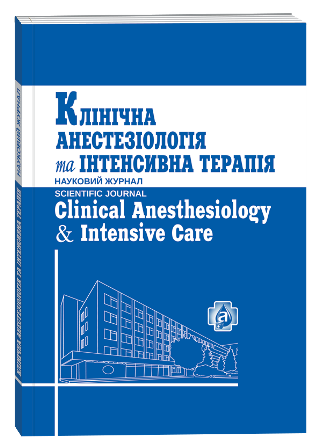ACUTE KIDNEY INJURY IN PEDIATRIC SEPSIS. VASOACTIVE MEDIATORS, RENAL HEMODYNAMIC AND NOWEL ABILITY OF PROGNOSIS
Keywords:
pediatric sepsis, acute kidney injuryAbstract
Background. Acute kidney injury (AKI) is common complication of sepsis and MODS. Development of AKI during sepsis increases patient morbidity, predicts higher mortality. Renal hemodynamic instability is the possible factor of sepsisinduced AKI. In the available scientists resources we has not found data about kidney hemodynamic in pediatric sepsis with AKI. Aim — to examine the blood flow in main renal vessels in children with sepsis; to establish the relationship between blood flow and the functional state of the kidneys, the vasoactive mediator’s level; to establish dopplerographic markers and predictors of AKI development in pediatric sepsis. Materials and methods. A complex study of the kidney, homeostasis, and renal blood flow in the main arteries and veins in 170 children with and without septic with AKI was conducted. Results. There are shown significant kidneys blood flow changes, such as increase of the resistive and pulsatility index in pediatric sepsis with AKI. These changes are associated with signs of endothelial dysfunction. The assessment of PI and IR main kidneys veins are predicting the development AKI of pediatrics’ sepsis. Conclusions. Pediatrics’ sepsis AKI is associated with impaired renal blood flow such as arterial and venos vasoconstriction. IR and PI of main renal veins may be an effective measurement for prediction and diagnosis of AKI. They increase above 43 for IR and 61 for PI are sensitive and specific to AKI development.
References
The epidemiology of severe sepsis in children in the United States / R. S. Watson, J. A. Carcillo, W. T. Linde-Zwirble [et al.] // Amer. J. Respir. Crit. Care Med. – 2003. – Vol. 167. – P. 695–701.
EPISEPSIS: a reappraisal of epidemiology and outcome of severe sepsis in French intensive care units / C. Brun-Buisson, P. Meshaka, P. Pinton [et al.] // Intensive Care Med. – 2004. – № 4. – P. 580–588.
Epidemiology of sepsis in Germany: results from prospective multicenter study / C. Engel, F. M. Brunkhorst, H.-G. Bone [et al.] // Intensive Care Med. – 2007. – № 4. – P. 606–618.
Zarjou A. Sepsis and Acute Kidney Injury / A. Zarjou, A. Agarwal // J. Am. Soc. Nephrol. – 2011. – Vol. 22. – Р. 999–1006.
Septic versus non-septic acute kidney injury in critically ill patients: characteristics and clinical outcomes. / M. Cruz, J. G. Athayda de Olivera Dantas, T. M. Levi [et al.] // Rev Bras Ter Intensiva. – 2014. – Vol. 26 (4). – P. 384–391.
Poukkane M. Acute kidney injury in severe sepsis and septic shock / M. Poukkane // Academic dissertation. – Helsinki, 2015. – 108 p.
Association between systemic hemodynamics and septic acute kidney injury in critically ill patients: a retrospective observational study / M. Legrand, C. Duplus, C. Simon [et al.] // Crit. Care. – 2013. – Vol. 17. – R. 278.
Bilgili B. Sepsis and Acute Kidney Injury / B. Bilgili, M. Haliloglu, I. Cinel // Turk J Anaesth Reanim. – 2015. – Vol. 42. – P. 294–301.
Renal Resistive Index Better Predicts the Occurrence of Acute Kidney Injury than Cystatin C / D. Schnell, S. Deruddre, A. Harrois [et al.] // Shock. – 2012. – Vol. 38. – P. 592–597.
Schnell D. Bedside Doppler ultrasound for the assessment of renal perfusion in the ICU: advantages and limitations of the available techniques / D. Schnell, M. Darmon // Critical Ultrasound Journal. – 2015. – Vol. 7, N 8. – DOI 10. 1186/s13089-015-0024-6.







